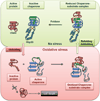Conditional disorder in chaperone action
- PMID: 23018052
- PMCID: PMC3508372
- DOI: 10.1016/j.tibs.2012.08.006
Conditional disorder in chaperone action
Abstract
Protein disorder remains an intrinsically fuzzy concept. Its role in protein function is difficult to conceptualize and its experimental study is challenging. Although a wide variety of roles for protein disorder have been proposed, establishing that disorder is functionally important, particularly in vivo, is not a trivial task. Several molecular chaperones have now been identified as conditionally disordered proteins; fully folded and chaperone-inactive under non-stress conditions, they adopt a partially disordered conformation upon exposure to distinct stress conditions. This disorder appears to be vital for their ability to bind multiple aggregation-sensitive client proteins and to protect cells against the stressors. The study of these conditionally disordered chaperones should prove useful in understanding the functional role for protein disorder in molecular recognition.
Copyright © 2012 Elsevier Ltd. All rights reserved.
Figures




Similar articles
-
Conditional Chaperone-Client Interactions Revealed by Genetically Encoded Photo-cross-linkers.Acc Chem Res. 2017 May 16;50(5):1184-1192. doi: 10.1021/acs.accounts.6b00647. Epub 2017 May 3. Acc Chem Res. 2017. PMID: 28467057
-
Structural basis and mechanism of the unfolding-induced activation of HdeA, a bacterial acid response chaperone.J Biol Chem. 2019 Mar 1;294(9):3192-3206. doi: 10.1074/jbc.RA118.006398. Epub 2018 Dec 20. J Biol Chem. 2019. PMID: 30573682 Free PMC article.
-
No structure, no problem: Protein stabilization by Hero proteins and other chaperone-like IDPs.Biochim Biophys Acta Gen Subj. 2025 May;1869(6):130786. doi: 10.1016/j.bbagen.2025.130786. Epub 2025 Mar 2. Biochim Biophys Acta Gen Subj. 2025. PMID: 40037507 Review.
-
Chaperone-Bound Clients: The Importance of Being Dynamic.Trends Biochem Sci. 2019 Jun;44(6):517-527. doi: 10.1016/j.tibs.2018.12.005. Epub 2019 Jan 2. Trends Biochem Sci. 2019. PMID: 30611607 Review.
-
HdeB functions as an acid-protective chaperone in bacteria.J Biol Chem. 2015 Jan 2;290(1):65-75. doi: 10.1074/jbc.M114.612986. Epub 2014 Nov 12. J Biol Chem. 2015. PMID: 25391835 Free PMC article.
Cited by
-
Binding and folding of the small bacterial chaperone HdeA.J Phys Chem B. 2013 Oct 24;117(42):13219-25. doi: 10.1021/jp403264s. Epub 2013 Jul 1. J Phys Chem B. 2013. PMID: 23738772 Free PMC article.
-
Super Spy variants implicate flexibility in chaperone action.Elife. 2014;3:e01584. doi: 10.7554/eLife.01584. Epub 2014 Feb 4. Elife. 2014. PMID: 24497545 Free PMC article.
-
Dancing Protein Clouds: The Strange Biology and Chaotic Physics of Intrinsically Disordered Proteins.J Biol Chem. 2016 Mar 25;291(13):6681-8. doi: 10.1074/jbc.R115.685859. Epub 2016 Feb 5. J Biol Chem. 2016. PMID: 26851286 Free PMC article. Review.
-
Resolving the ambiguity: Making sense of intrinsic disorder when PDB structures disagree.Protein Sci. 2016 Mar;25(3):676-88. doi: 10.1002/pro.2864. Epub 2016 Jan 9. Protein Sci. 2016. PMID: 26683124 Free PMC article.
-
Structural model of dodecameric heat-shock protein Hsp21: Flexible N-terminal arms interact with client proteins while C-terminal tails maintain the dodecamer and chaperone activity.J Biol Chem. 2017 May 12;292(19):8103-8121. doi: 10.1074/jbc.M116.766816. Epub 2017 Mar 21. J Biol Chem. 2017. PMID: 28325834 Free PMC article.
References
-
- Le Gall T, et al. Intrinsic disorder in the Protein Data Bank. Journal of biomolecular structure & dynamics. 2007;24:325–342. - PubMed
-
- Uversky VN. Intrinsically disordered proteins from A to Z. Int J Biochem Cell Biol. 2011;43:1090–1103. - PubMed
-
- Tompa P, Fuxreiter M. Fuzzy complexes: polymorphism and structural disorder in protein-protein interactions. Trends Biochem Sci. 2008;33:2–8. - PubMed
-
- Tompa P, et al. Prevalent structural disorder in E. coli and S. cerevisiae proteomes. J Proteome Res. 2006;5:1996–2000. - PubMed
Publication types
MeSH terms
Substances
Grants and funding
LinkOut - more resources
Full Text Sources
Molecular Biology Databases

